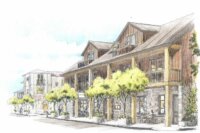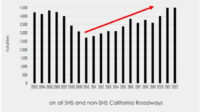SB 610 (WIENER) would eliminate Fire Hazard Severity Zone (FHSZ) mapping to open more areas for housing density. According to the bill’s opponents, a list that includes nearly 100 environmental and development watchdog groups statewide, this legislation has been misleadingly described as not related to housing. They say this is untrue and that it would significantly affect all areas with fire hazards.
SB 610, opponents claim, is at odds with the Governor’s Strike Force recommendations, which caution against further development in high-risk areas. SB 610 is designed to promote more development in areas currently designated as fire risk areas without “costly building standards, increased disaster planning and mitigation requirements.” This conflicts with the Governor’s Strike Force’s recommendations, which urge the state to “begin to deprioritize new development in areas of the most extreme fire risk. In turn, more urban and lower-risk regions in the state must prioritize increasing infill development and overall housing production.” Many wildfire zones are also natural lands or wildlife habitat, and this bill would pave the way for more development in those areas, undermining the state’s goal to conserve at least 30 percent of California’s land and coastal waters by 2030 to combat the climate and biodiversity crises.
This contrasts with the position of legislation backers. On a document produced by Weiner’s office, the argument is made that the current FHSZ process has numerous problems. Namely, there is currently no Statewide adopted map for Local Responsibility Area Fire Hazard Severity Zones (LRA FHSZs). The current Local Responsibility Area (LRA) process lacks a public comment process and results in inconsistent wildfire mitigations that are not science-based due to the current tiering system of FHSZs.
SB 610 would intensify the state’s insurance crisis, according to its critics. SB 610’s official fact sheet laments “the public perception that FHSZ classifications influence insurance availability and pricing . . .” and cites “increasing home insurance premiums” as a reason for the bill. While the fact sheet is correct that insurance availability is decreasing while premiums increase, SB 610 would make these existing challenges far worse. The insurance industry uses their own risk assessments to decide whether to insure a given area and at what rates. Insurers are not leaving the state or increasing rates because of the labels state or local officials placed on high-risk areas, but because these are in fact high-risk areas threatened or burned by wildfires. Building in high-risk areas is a driver of the problem, and building more in these areas will only make the problem worse, regardless of whether these areas are called “fire hazard zones” or “wildfire mitigation areas.”
Critics note that a report from the California Department of Insurance’s Climate Insurance Working Group states: “Land use decisions in the past are one of the causes of insurability problems today. Where and how Californians build and rebuild has consequences for the severity of losses, the degree of economic and physical resilience, and the insurability of properties, both now and in the long term. Housing in risky areas can sometimes be less expensive; but housing that burns down or repeatedly floods is not an affordable or equitable option because it leaves vulnerable people exposed to danger and the destruction of their homes and possessions.” The report warns that when state and local governments fail to consider the full costs of development, “additional costs may be borne by state or federal taxpayers when disaster strikes, thus potentially creating a perverse incentive to approve development that is ill-advised.”
Opponents objections are many. SB 610 misleads the public, they say, with the false premise that development in high fire hazard zones can be rendered safe. Mitigation can make development in fire zones less risky, but not safe. Home hardening and defensible space are essential for already existing structures, but such measures only reduce the chance of burning. In the Thomas Fire of 2017 in Ventura, the great majority of structures damaged or destroyed had fire-resistant roof construction and fire-resistant exterior siding. In addition, an analysis conducted in the aftermath of the Camp Fire showed that only 44 percent of homes built to current Chapter 7A building codes survived, meaning 56 percent were destroyed (and only 11.5 percent of older homes built before 1997 survived). And evacuation routes are already stressed past the breaking point. As Los Angeles County has shown, regional housing needs allocation goals can all be met by directing new development outside of fire zones.
Moreover, largescale development in areas currently designated as very high fire hazard severity zones could result in a host of unintended yet foreseeable consequences such as increasing ignition risk, obstructing existing communities’ evacuation routes, disrupting natural fire regimes, harming California’s ecosystems and wildlife, impairing air quality, increasing medical emergencies and premature death of vulnerable community members, harming firefighters, and increasing firefighting costs.
The legislative analysis in Assembly Natural Resources Committee similarly notes: “Residential developments in the WUI and other wildfire prone areas can significantly increase the risks of wildfires and the risk to public safety.” SB 610 will make these existing problems worse by making it easier to build in high-risk areas. As climate change intensifies, wildfire will become an increasing hazard. It is no wonder that the Attorney General’s office intervened in multiple cases challenging local decisions that allowed development in fire-prone areas.
Additional criticism of the bill includes the charge that SB 610 mischaracterizes the current role of fire risk in the siting of development. SB 610’s fact sheet asserts that fire zones are “weaponized locally as an anti-housing/development tool” and that current fire maps “impact housing development” even though “the maps were never intended to be used as a deterrent or a moratorium on fire safe housing.” This, say critics, is inaccurate.
They note that there are existing state laws allowing for “streamlining” of development in some instances if a project is not in a fire zone, and that prohibit streamlining if the project is in a fire zone. Last year’s AB 1633 (Ting) gave developers more leverage to challenge a city’s denial of a project, but the law did not apply to projects that were in high or very high fire hazard severity zones. Similarly, the CEQA streamlining provisions in SB 423 (Wiener) do not apply in very high fire hazard severity zones or state responsibility areas unless the project complies with various fire mitigation standards and regulations. State policy includes heightened requirements and approval processes for development in fire zones because it is inherently risky.
Significantly, opponents say SB 610 strips city and county authority to designate fire zones within their own jurisdictions despite their critical role in wildfire risk reduction. Existing law allows both cities and counties to designate areas as fire zones (known as “local responsibility areas”) as well as the state (through moderate, high, and very high “fire hazard severity zones”). SB 610 would prevent cities and counties from designating fire zones based on scientific information and instead fully centralize such designations and decision-making in the hands of the State Fire Marshal, a single unelected official.
In their letter citing concerns with SB 610, the California League of Cities writes, “Local agencies – cities, counties, and special districts – will continue to manage fire suppress[ion] and conduct vegetation management efforts in the LRAs, therefore, they should also retain the ability to provide their local expertise in designating these areas.” California League of Cities urged that the bill be revised so that “local agencies retain the ability [to] expand beyond the state’s wildfire mitigation areas based on substantial evidence within their jurisdictions, should it be necessary.”
Currently, the nine-member Board of Forestry and Fire Protection has primary authority over developing wildfire regulations in fire zones. By doing away with the entire fire hazard classification system, SB 610 shifts primary authority to the State Fire Marshal, which decreases public transparency and increases the possibility of undue political influence.
SB 610 would reshape California fire policy via a gut-and-amend process without adequate hearings. or stakeholder engagement. The bill, critics advise, should be tabled until stakeholders and local jurisdictions have adequate time to engage in the legislative process.
According to Weiner’s office, previous legislation and trailer bill language in this code section amended the CalFIRE FHSZ LRA map process, including attaching new provisions to LRAs, such that this process may be weaponized locally as an anti-housing/development tool. In practice, LRA maps can functionally result in restrictions on growth through imposing costly building standards, increased disaster planning and mitigation requirements, or increasing home insurance premiums.
Weiner and the bill’s proponents note that once the recommended LRA’s maps are sent to local agencies, jurisdictions can make the LRA maps more restrictive but cannot correct maps to make the zones less restrictive. Unlike State Responsibility Areas (SRAs,) there is no map appeal process for the LRA maps—any altered LRA maps by local agencies are final and non-rebuttable by the SFM. Local jurisdictions then have the ability to misuse this process and make the majority of their community a High/Very High FHSZ through an LRA map that would impact housing development for 10- 20 years until the maps are updated.
Additionally, advise proponents, the current LRA process lacks Statewide oversight and enforcement for local ordinance adoptions of FHSZs. Consequently, the Fire Hazard Severity Zone (FHSZ) maps are often misinterpreted as identifying risk, but the maps were never intended to be used as a deterrent or a moratorium on fire safe housing or as a method to determine insurance rates. The maps are simply intended to identify areas where mitigations are necessary. These inconsistencies have resulted in a lack of consistent adoption of mitigations in the LRA and the public perception that FHSZ classifications influence insurance availability and pricing, as well as housing prices.
To solve these problems, says Weiner’s office, SB 610 would remedy the issues with the existing FHSZ process by empowering CAL FIRE – Office of the State Fire Marshal to use its science-based hazard model to develop the Wildfire Mitigation Area (WMA). Under SB 610, the SFM would collaboratively develop appropriate and consistent Statewide minimum mitigation requirements for the WMA through a public process. SB 610 provides for a robust public meeting process and would allow the State Fire Marshal (SFM) to review feedback and adjust the WMA Map where warranted. This approach would restrict the ability of expanding or reducing the WMA boundaries to the SFM.
Finally, says the bill’s author, the SFM would also adopt science-based minimum mitigation requirements for the WMA that would be developed collaboratively with appropriate stakeholders and would be consistent throughout the WMA. Consistent wildfire mitigation requirements for the building industry, as instituted by SB 610, would resolve current concerns over what mitigations are required, which could expedite fire-adapted development.
In an area like Sonoma Valley, the risk of devastating fire is high, and residents are very concerned about evacuation and associated fire risks. The loss of local control under the guise of facilitating the creation of new housing, opponents believe, is misguided. Wildfire risk management, they advocate, is something best determined locally, not by Sacramento. If the bill passes, it will then go to Governor Newsom for his signature.
For those interested, the email address for Governor Newsom is: [email protected]





Be First to Comment